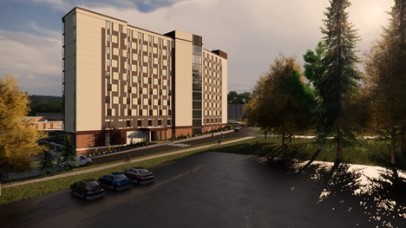On many urban, and some suburban campuses, the best solution for a new residence hall is often a high-rise facility due to limited site availability and footprint restrictions. With diligent design by a student housing expert like KWK Architects, a high-rise residence hall can accommodate any building program and provide all the space needed for student residents, social and academic gatherings and support areas.
A high-rise residence hall can be the best solution for a campus and can be attractively designed to provide a facility that supports and adds to the overall student experience. When designing and budgeting for a high-rise residence hall, there are additional considerations related to building codes and safety that must be taken into account at the start.
There are several classifications of high-rise structures: occupied floor height less than 120 feet, more than 120 feet and more than 420 feet. Most high-rise residence halls are under the 120-foot building height limit. Additional requirements apply for taller structures, such as fire service elevators in buildings over 120 feet to assist in evacuations and an additional sprinkler riser and main water service for buildings over 420 feet.
These code requirements do add to the building cost but may well be offset by achieving the higher density of student beds on the site and the associated revenues.
From a code perspective, a high-rise is any building that has the highest occupied floor more than 75 feet above the lowest point around the building where the fire department will come to respond to a fire event. With typical residence hall floor-to-floor heights, high-rise code requirements typically start to apply at a 7-8 story hall.
There are many variables that can affect this, such as a main public level with tall floor-to-floor heights or a sloping site with fire access down a level. Because of the height of a high-rise residence hall, emergency evacuation is not possible and a fire would need to be fought internally, so high-rise residence halls have additional code features to ensure occupant safety.
High-rise residence halls rely heavily on automatic sprinkler systems for fire safety. These systems have been used successfully for many years and are proven effective. High-rise structures in areas with earthquake activity must also have a secondary water supply to the sprinkler system in case a seismic event disables the primary water source.
In high-rise buildings, fire pumps are usually needed to provide water pressure for the sprinklers. Fire pump design depends on the interaction between the local water system, height of the building, and design of the sprinkler and standpipes. Fire pumps must also be located in rooms with a fire-rated enclosure and with ideally direct access from the exterior. If not directly accessible from the exterior, then a fire-rated passageway from the entry point to the fire pump room is required so that firefighters can safely travel to the pump room. Codes dictate the size of the room and its emergency system panels and furnishings, plus its location must be coordinated with the local fire marshal.
Emergency detection and alarm systems play a critical role in life safety in a high-rise residence hall. These systems detect smoke and heat in the building, notify occupants of the hazard and the proper response to a fire or other event, and allow emergency responders to assist the occupants and fight the fire.
These systems include automatic smoke detectors, which detect a fire in its early stages; fire alarms, which warn people with visual and audible alarms about a possible fire, smoke or carbon monoxide occurrence in a specific building area; standpipes which provide a source of water to fire fighters throughout the building; emergency voice/alarm communication systems which direct occupants in the portion of the building with a fire to an exit or area of refuge and notifies the fire department; and lastly, an emergency radio responder system which ensures that the fire fighters on the ground will be able to communicate with responders throughout the building. These systems must be available in the event of a power failure and are required to have standby or emergency power typically provided by a generator.
In addition to the emergency alarm systems, various areas are required within high-rise buildings to assist emergency responders. One of those facilities is a fire command center that provides a centralized room for fire operations. Its location would need to be determined with the local fire marshal; code dictates the room’s minimize size, dimensions, emergency system control panels and its furnishings. The fire command center is best located on the main level and easily accessible from the exterior.
A second requirement is a smoke removal system for post-fire operations. Part of post-fire operations is to search the building for any remaining hidden fires, or “hot-spots”, and to stabilize the structure. A post-removal system allows the fire fighters to exhaust the smoke and combustion products from the building so that they can work safely. The system can be a natural type, such as windows spaced appropriately around the building perimeter, or a mechanical type with ventilation equipment, or a combination of both.
Stairs in high-rise residence halls can become pathways for smoke to move through the building, given their construction as vertical shafts connecting all floor levels. To prevent this, stairs in high-rise buildings must be smoke-proof enclosures and pressurized by providing air from the mechanical system at a higher pressure than the remainder of the floor and restricting air flow to the space.
KWK Architects has recently designed a proposed new high-rise residence hall (10 stories/350 beds) at the University of Minnesota Duluth. For more information about high-rise residence hall design, contact KWK Architects Principal Javier Esteban at 314-578-6221 or javiere@kwkarchitects.com.





